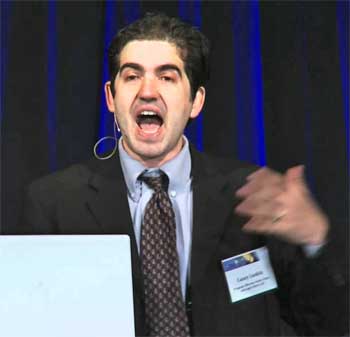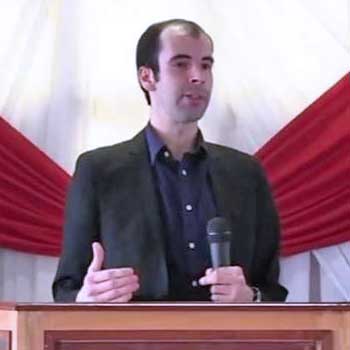
Casey Luskinʼs third response (indented) followed by my own is below. He does not say whether or not he has yet read my second response, especially since he admitted that he had not read my first. Gauging by his citation of “William Thomas” he apparently has not done so. Concerning his citation of Thomas, I.D.ists continue to misconstrue or attempt to bury the most obvious evidence from nature that their Designer appears at best to be a Tinkerer. They rely on the argument “thatʼs a theological, not a scientific objection,” but the Tinkerer hypothesis raises valid questions based on the evidence from nature that I cited. It also reduces the distance between a Designer and Nature alone since it lay on a spectrum between those two poles. The first three paragraphs below are Caseyʼs, followed by my latest response.
Hi Ed, If youʼve “read ID material for years,” then why do you misrepresent basic ID arguments and mis-state how ID proponents detect design? Natural evil, or “suboptimality” donʼt refute design.
If youʼve “read ID material for years,” why do you fail to engage the ID research papers I cited, instead quibbling over details of their review? (They were reviewed by qualified scientists, many of which werenʼt pro-ID.) Todd Woodʼs ideas on this are irrelevant. Your response doesnʼt address ANY of this progress. Instead, you post walls of text off-list about pesticide resistance (something ID proponents readily acknowledge, even by evolving redundant copies of the SAME GENE), neutral mutations (which arenʼt adaptive), and irrelevant points about wasted sperm.
You also mention various diseases—the very “argument from evil” William Thomas called a “theological objection, not a scientific one.” Perhaps you have “read ID material for years.” But you arenʼt engaging with that material.
Hi Casey,
I agree my points are indeed wasted, on you, because you do not understand evolution. Cornelius Hunter and the film that I.D.ists produced (see Expelled Exposed) mocks evolution as “progress” achieved via a highway of blood. But evolution defined in the largest sense is not progress in a straight line sense of the word but radiation, bushes of variant species, trial and error. And that includes species AVOIDING conflict via incessant mutations that take them in a multitude of directions not just one, which means they are filling a growing diversity of ecological niches instead of fighting constantly over a single niche. That recognition makes mincemeat out of the incessant misrepresentations of evolution by I.D.ists.
Along those same lines, evolution includes the fact that the majority of all species on earth are parasites, freeloaders on other species to some degree (including cases of mutually freeloading on each other). And the most successful and prolific parasites do NOT kill their hosts. Heck, every single eukaryote cell has many bacteria-like organelles existing inside it in the form of mitochondria. So our own cells are probably the result of bacteria that evolved a freeloading lifestyle inside a larger cell that evolved. Even viral DNA has found a way to mutually co-exist and flourish inside the eukaryote cell in the form of endogenous retro-viral DNA that has recently been found to be linked to jumping genes and stem cell regulation. So bacteria as well as viruses are living together inside our own cells which appear to have evolved a lifestyle of mutuality, and evolution appears jury-rigged, using “whatʼs there” to make something new, the larger eukaryotic cell out of the earlier prokaryotic cell (bacteria) and viruses. Thatʼs the rest of the story of evolution, that mutuality. I have also mentioned that evolution primarily involves differential reproduction, which means even competition over mates in sexually reproducing forms of life most often does not involve the death of either male competitor but a backing off of one of them.
You challenged me to “engage” when you canʼt even get past the first line of my posts. The “engagement” with the pro-I.D. papers you mentioned is already taking place, at BIOLOGOS (a pro-Christian site), and elsewhere on the web. As I said, you can use my dedicated search engine to discover where this is happening (or has already happened).
And simply writing off Todd Wood does you no good. He has an advanced degree in biology from a major secular institution and has worked with secular specialists specifically in the field of DNA research. Woodʼs own study of the human and chimpanzee genome proved to him that the genetic evidence raises problems for those who wish to deny common descent. He also admits that evolution is not a theory in crisis, but believes his case is best served by remaining calm and attempting to build up alternative interpretations, but he does not claim creationism is as comprehensive as evolutionary theories and hypotheses at present. In contrast I.D. folks like yourself seem to think and act like evolution is already past being refuted.
Speaking of which, I agree with you that “sub-optimality” does not “refute” design. But if you are willing to admit “sub-optimality,” then please admit you MAY be speaking about a Tinkerer that is not necessarily an all-knowing and all-powerful Designer who could create everything in the blink of an eye exactly as preconceived and totally optimal.
A Tinkerer fits the evidence quite well, a Tinkerer whose work required over a trillion planets and billions of years before life appeared on a few of them. A Tinkerer that required countless mutations, both natural and tinkered together, and countless generations to produce countless extinct species, including extinct cousin species, extinct cousins of cousin species, before “finishing their Grand Tinkering.”
Hypothesizing a Tinkerer may be a step up from hypothesizing that Nature was inherently the tinkerer (Naturalism), but itʼs certainly as reasonable to hypothesize a Tinkerer as it is to hypothesize an all-knowing and all-powerful Designer given all the evidence from nature that I cited in my second reply, here.
And for all we know this same Tinkerer could have been Tinkering around creating countless cosmoses just as it was tinkering around with the creation of countless planets until life arose on a few of them. If it took over a trillion planets before life could arise on a few of them in our cosmos, maybe it took countless cosmoses before one arose in which planets could also arise.
Likewise it took untold numbers of species that became extinct before the world was filled with ones that the Tinkerer felt were “just right,” and even then there remained species inimical to human life — indeed most of the cosmos remains inimical to life. And for all of the eons the Tinkerer spent tinkering with genomes, the Tinkerer left genes inside both plants and animals that were inimical to their own lives, genes for cancer and other diseases.
So my point is not that anyone has “refuted design,” but that the evidence is not so clear concerning the type of Designer that might actually exist. And a Tinkerer certainly fits natureʼs oh so visible sub-optimal ways, taken as a whole.
I also understand how difficult it is to “refute” any big idea in philosophy. Arguments over nature and supernature, monism and dualism, the one and the many, have been going on since the days of the pre-Socratic philosophers 2,500 years ago. The pieces of the philosophical pie of Big Questions have merely been cut and re-cut into ever smaller, more precisely worded slices, but the ingenuity of each defender of each slice continues the debate. With that being said, yes, “nothing refutes design,” for the simple reason nothing refutes the reply that “I believe a miracle happened here.” For all we know cork was designed in order that humans might store wine in casks and bottles. For all we know the human nose was placed squarely between the eyes in order to support eyeglasses. For all we know sand was designed so that we might build computers out of silicon chips. But what a lengthy arduous path it has been for humans to acquire such knowledge concerning how to use nature to our own ends. Is that by design, or are we each little tinkerers, tinkered together in the somewhat near image of a Great Tinkerer?
Speaking of tinkering (if our species and its civilization survives) then quantum computers might one day be linked to sensors as acute as our eyes and ears, and to a program that accumulates and compares knowledge, a learning program, thus joining our species in the long arduous quest for further knowledge. Aside from that possibility, itʼs also a big enough cosmos such that it deserves more of a look than simply peering through our narrow window pane of organisms on earth.
But, wait for it, here comes the I.D. refrain, “Look at the flagellum!” If an I.D.ist canʼt explain it nobody can. But discrete elements of the flagellum are not absent completely from other known species of bacteria on our planet. And who knows what we might discover on other planets or moons in the way of single-celled life forms? Weʼd all like to be able to look at the single-celled species of bacteria and eukaryotes in the distant past on earth but the paleontological evidence from that far back is absent aside from a few fossils of single celled species, coupled with whatever we can glean from the species today. But bacteria have been exchanging DNA in ways that sexually reproducing species cannot do, so tracing all their evolutions in the past, especially during the time when bacteria first arose and when single-celled life forms were the only ones on the planet for around 2 billion or more years, remains impossible. But that does not make modern day species of bacteria and eukaryotes that have “flagella” evolutionʼs demise. And for all we know if human civilization and curiosity last long enough we might discover at least one nearby planet or moon that contains nothing but single-celled life forms, perhaps some featuring flagella with some of their nearest cousins still around as well. The truth is that we havenʼt gotten off the cradle planet yet.
A paraphrased quotation from Mark Twain appears appropriate here: “We have all kinds of trouble solving man-made mysteries, but when it comes to the mystery of God/Designer et al vast numbers of people claim to have it figured out.”



